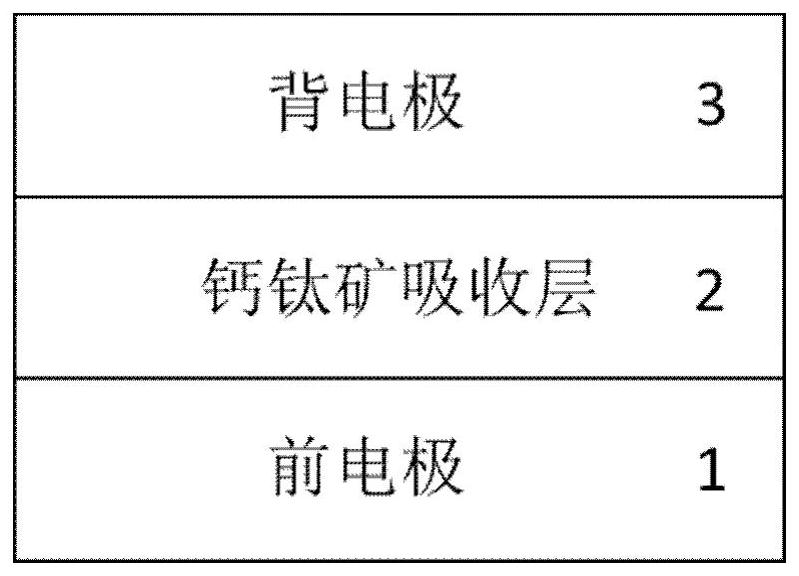Nuclear radiation detector based on two-dimensional perovskite single crystal and preparation method thereof
A nuclear radiation detector and perovskite technology, applied in the field of nuclear radiation detectors, can solve the problems of low carrier mobility and lifetime, low detection sensitivity, and many defects in perovskite, so as to improve the lifetime and mobility. , the effect of increasing exciton diffusion length and reducing traps and defects
- Summary
- Abstract
- Description
- Claims
- Application Information
AI Technical Summary
Problems solved by technology
Method used
Image
Examples
Embodiment 1
[0031] Embodiment 1: the electrode before preparation adopts gold, and the two-dimensional perovskite absorption layer adopts (C 3 h 7 NH 3 ) 2 PbBr 4 , nuclear radiation detector with gold back electrode
[0032] Step 1, preparation (C 3 h 7 NH 3 ) 2 PbBr 4 solution and chlorobenzene anti-solvent solution.
[0033] 1.1) 36.7 grams of lead bromide PbBr 2 and 28 grams of propylammonium bromide C 3 h 7 NH 3 Br was added to 100 ml of dimethylformamide solvent and stirred at room temperature for 24 hours to obtain (C 3 h 7 NH 3 ) 2 PbBr 4 solution;
[0034] 1.2) Add 100 milliliters of chlorobenzene solvent into a jar to obtain a chlorobenzene anti-solvent solution.
[0035] Step 2, grow (C 3 h 7 NH 3 ) 2 PbBr 4 single crystal.
[0036] will be loaded with (C 3 h 7 NH 3 ) 2 PbBr 4 The sample bottle of solution is placed in the jar that chlorobenzene solution is housed, then jar is placed in the oven of constant temperature 25 degrees centigrade and sta...
Embodiment 2
[0043] Example 2: Silver is used for the electrode before preparation, and (PEA) is used for the two-dimensional perovskite absorber layer 2 PB 4 , the back electrode adopts silver nuclear radiation detector.
[0044] Step 1, 49.8 grams of phenethylamine iodide PEAI and 46.1 grams of lead iodide were dissolved in 100 milliliters of butyrolactone solvent, stirred at room temperature for 24 hours to obtain (PEA) 2 PB 4 solution.
[0045] Step 2, the prepared (PEA) 2 PB 4 The solution is placed in an oven, and the initial temperature of the oven is set to 80 degrees Celsius, and then the temperature is cooled to 30 degrees Celsius at a rate of 1 degrees Celsius / hour to grow (PEA) 2 PB 4 single crystal.
[0046] Step 3, preparing the front electrode.
[0047] First, the (PEA) 2 PB 4 The upper surface of the single crystal is placed downwards in the mask plate of the chamber of the vacuum coating instrument, and silver with a purity of more than 99.9% is placed in the eva...
Embodiment 3
[0050] Embodiment 3: the electrode before preparation adopts nickel, and the two-dimensional perovskite layer adopts (C 4 h 9 NH 3 ) 2 (CH 3 NH 3 )Pb 2 I 7 , nuclear radiation detector with nickel back electrode
[0051] Step A, C 4 h 9 NH 3 ) 2 (CH 3 NH 3 )Pb 2 I 7 solution.
[0052] 40.2 g of butyl ammonium iodide C 4 h 9 NH 3 I, the methyl ammonium iodide CH of 15.9 grams 3 NH 3 PbI and 92.2 grams of lead iodide were dissolved in 100 milliliters of dimethylformamide solvent, stirred at room temperature for 20 hours to obtain (C 4 h 9 NH 3 ) 2 (CH 3 NH 3 )Pb 2 I 7 solution.
[0053] Step B, grow (C 4 h 9 NH 3 ) 2 (CH 3 NH 3 )Pb 2 I 7 single crystal.
[0054] The prepared (C 4 h 9 NH 3 ) 2 (CH 3 NH 3 )Pb 2 I 7 The solution is placed in an oven, and the initial temperature of the oven is set to 30 degrees Celsius, and then the temperature is raised to 90 degrees Celsius at a rate of 2 degrees Celsius / day, and the (C 4 h 9 NH 3 ) ...
PUM
| Property | Measurement | Unit |
|---|---|---|
| Thickness | aaaaa | aaaaa |
| Thickness | aaaaa | aaaaa |
Abstract
Description
Claims
Application Information
 Login to view more
Login to view more - R&D Engineer
- R&D Manager
- IP Professional
- Industry Leading Data Capabilities
- Powerful AI technology
- Patent DNA Extraction
Browse by: Latest US Patents, China's latest patents, Technical Efficacy Thesaurus, Application Domain, Technology Topic.
© 2024 PatSnap. All rights reserved.Legal|Privacy policy|Modern Slavery Act Transparency Statement|Sitemap


